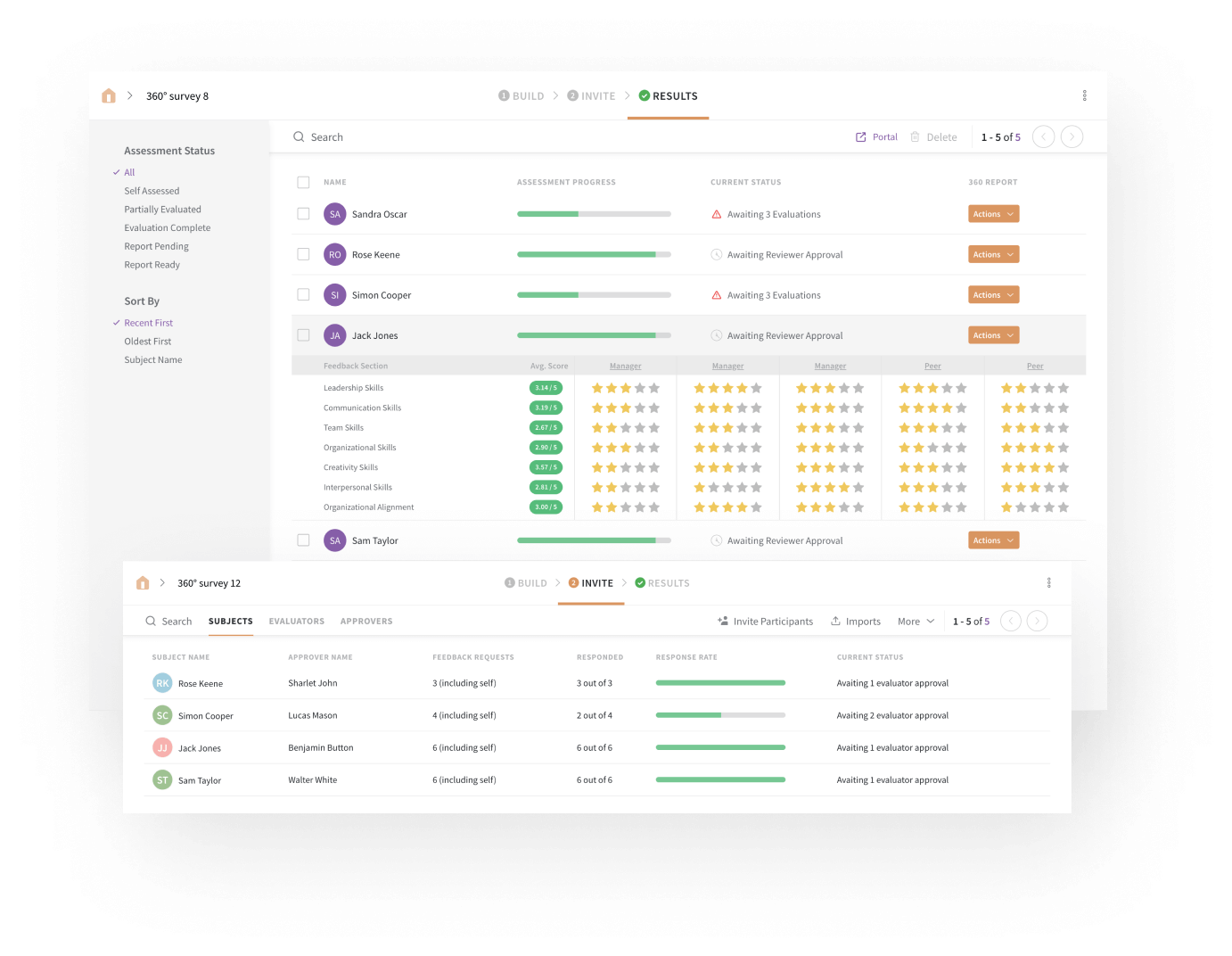Employee Experience
Employee Experience Strategy: Do's and Don'ts
Article written by Kate Williams
Product Marketing Manager at SurveySparrow
12 min read
19 September 2025

Imagine this.
Anytime you visit your favorite cafè, you choose to have the same coffee order. The barista soon realizes that you are a regular customer and notes down your usual purchase. So the next time you visit them, they have your order ready to go.
Wouldn’t you agree that this small gesture would make your customer experience more enjoyable? We like to think so! When the barista remembers you and your order, it can make you feel valued as a customer. But have you ever wondered what it’s like to be on the other side of the check-out counter?
Employee experience, like customer experience, is a crucial aspect of running a business because it plays a significant role in determining client satisfaction. A happy and satisfied employee is more likely to cater to the customers’ needs, thereby improving their experience with a company. And so, companies must do their best to invest in a brilliant employee experience strategy.
Now, if you are unsure how to go about this, you’ve come to the right place! To help you navigate best practices in employee experience, we’ve compiled a list of dos and don’ts. So, let’s take a look!
What Is Employee Experience Strategy?
Before we let the cat out of the bag soon, on what a successful employee experience strategy looks like, let’s address the question of employee experience.
The employee experience is what an employee goes through at your company. From the hiring and onboarding steps to the exit interview, the employee experience accounts for everything.
High employee retention is a strong indicator of a powerful employee brand 🔥 When you have disengaged employees looking elsewhere to fulfill their need to grow, it costs the company in recruiting time and productivity. #EmployeeEngagement pic.twitter.com/ZxUHN48w3Y
— Hirebook (@hirebookcom) November 23, 2020
Simply put, an employee’s experience is of three kinds – the cultural, the physical, and the technological.
1. The Cultural
This is perhaps the most understood part of the employee journey. The working culture, leadership style, and everything else in between are factors that influence this experience.
2. The Physical
These experiences are more tangible. They include things like desks, chairs, and other amenities that employees can access in the office.
3. The Technological
Such employee experiences are made up of the tools that a company gives them. It includes things like mobile devices, desktop computers, or user interfaces.
Companies often form an action plan to improve such employee experiences, called the employee experience strategy. But to build a successful strategy, you must understand your company’s culture, the employee’s expectations, and other such factors. Such strategies, then, rely on employee feedback to make improvements.
The Dos And Don’ts Of Improving Employee Experience Strategy
We’ve now addressed the question of what an employee experience strategy is. With that out of the way, let’s have a look at its do’s and don’ts.
1. Don’t Make Promises Only To Break Them.
You certainly do not want to make promises that you cannot keep. Not only does this erode your employees’ trust in you, but it also stops them from trying harder to achieve their goals. Further, it would destroy the company’s reputation by fostering a negative employee experience.
2. Do Leverage Rewards.
There is no denying that rewards are necessary for a workplace. But even if you do not hand out bonuses and promotions for every tiny achievement, let your employees know that they have done well!
3. Don’t Rely Only On Annual Reviews.
Employee satisfaction surveys are at the heart of all employee experience strategies. And so, it would be a mistake to rely on them just once a year. Instead, employers must enable real-time feedback systems, in addition to the annual reviews. This will help employees have an easily accessible feedback system.
4. Do Let Actions Speak Louder.
While it is well and good to make claims about the benefits you provide, make sure you follow through on them. Your actions are far more impactful than any claim you may make.
5. Don’t Ignore an Employee’s Concerns.
The worst thing an employer can do is ignore their employees’ concerns. Yes, negative feedback can be hard to hear, but they are the driving forces behind positive changes. So, do invest in a well-oiled feedback system that lets your employees voice their concerns.
6. Do Prioritize Transparency.
Today, most employees demand a fair and open workplace with enough transparency. Providing them with such experiences is crucial to ensuring a positive employee journey.
7. Don’t Leave Them In The Dark.
It is difficult to obtain any form of success without the full force of your employees behind you. As an employer, do you know how many employees identify and support the vision of your company? If you do, and it is not a significant number, you must educate them on this topic.
8. Do Listen To Employees Willingly.
Although it is laudable when employers give their employees enough room to speak up, it is pointless to not act on these suggestions. So, make it a point to bring in regular improvements.
9. Don’t Hesitate to Prioritize Employees.
The core tenet of employee experience management is making them a priority. The more an employer focuses on what makes their employees happy, the more productive the workplace gets.
Sometimes, this also means putting your employees before even the customers. In situations where clients turn rude and hostile towards an employee, many companies make the mistake of siding with the customer. However, doing so simply ensures that no good employee would ever stick around long enough for the company to profit.
10. Do Provide Them Flexibility.
If a company is smart enough to be reasonably flexible around their employees’ needs, they will have higher productivity rates. Employees are entitled to not answer work emails or phone calls within reasonable boundaries during their time off. So, a positive employee experience also accounts for what an employee goes through outside of the workplace.
11. Do Support Skill Development.
What’s the point of having a skill if it is not developed over the ages? In an office where technical skills are part and parcel, it is important to nurture them. To ensure an incredible employee journey and experience, employers must provide enough opportunities for skill development.
12. Don’t Micromanage.
If a manager looks over your shoulder all the time, we can guarantee that it would get annoying very quickly. And so, to ensure a positive work atmosphere, employees require some autonomy.
Of course, this is not to say that they should have free reign over everything. But if the administrators can place some trust in the employee’s judgments, they are sure to have a smoother experience.
13. Do Build A Sense of Community.
In the end, we are all social beings who enjoy spending time with our peers. As an employer, it is often in your best interests to foster a sense of community in the workplace. So, you may plan leisure trips, group activities, and gaming hours that help employees relieve some stress and make friends. If that doesn’t spell out a positive employee journey, then what could?
How Do You Measure Employee Experience?
Now let’s get to the best part – measuring employee experience. Are you wondering how to measure your employees’ satisfaction and engagement in the workplace? If you are, we’ve got some answers for you!
1. Creating An Employee Journey Map
Even if you are not an 18th-century seafarer, maps are still one of the best tools to explore unknown territory. This is true in terms of measuring employee experience as well.
Mapping out every encounter with your employees is the first step to gauging their experiences. From the moment they answer your job posting to the day they leave your company, the employee journey map covers all bases. In this way, you can ensure that there are no blind spots in your interactions with them.
This is how you can design the map:
1.1 Establish The Employee Persona
Not all employees are alike. So, their experiences will not be the same. This is why it is crucial to identify the different kinds of employees in your company.
1.2 Employee Journey Map For Every Persona
Next, you’ll need to make sure that you map out the journey of each segment or persona of your employees.
1.3 Rope In The Feedback
In the third step, you can add the relevant feedback for each persona to the map. This helps make the picture clearer in terms of employee experience management.
1.4 Get Everyone Onboard
Each step of the employee journey is likely handled by different teams, like HR for recruitments, team leaders for onboarding, and more. So, get them all to agree on one form of measurement.
1.5 Use Automation to Manage The Feedback
Get an automated feedback system that can collect suggestions from employees when they reach certain milestones. You can then save time and make the process more efficient.
1.6 Mix it All Up!
Combine the employee journey with the engagement survey to get a better picture of your company’s workings. For instance, you can ask your employees to fill out an onboarding survey when they complete their onboarding experience. Doing so lets you receive fresh feedback.
2. Employee 360 Surveys
The 360-degree style of surveying is effective in measuring an employee’s experience. This tool has an employee evaluated by multiple entities in the company, like the manager, clients, or coworkers.

An employee 360 survey allows employers to gauge how involved and engaged an employee is in the company. It looks at things like their rapport with their coworkers, their overall performance rates, and so on.
3. Employee Engagement And Satisfaction
Numerous companies like SurveySparrow have set out to bridge the gap between employees and employers. Now, companies can gauge the level of satisfaction and engagement their employees have in the company through employee surveys.
Top 3 Employee Experience Polls
Survey companies offer numerous types of polls, surveys, and feedback forms that a business can use to map their employees’ experiences. So, if you are searching for some of the best employee experience management polls, we have a few suggestions.
1. SurveySparrow
With a 40 per cent higher rate of responses, SurveySparrow is one of the best solutions for your company. Their 360-degree feedback software lets you create engaging employee experience polls that let you analyze their journeys with precision.
Here’s an employee performance review created using SurveySparrow.
To create similar employee evaluation surveys or employee performance reviews, sign up for free.
2. Officevibe
Officevibe is a similar polling tool that companies can use to measure their employee experiences. It gathers insights that help identify your employees’ satisfaction with your company.
3. Google Forms
Of course, this tech giant never disappoints with their free polling service, Google Forms! This service lets you create personalized polls, surveys, and feedback forms within minutes.
Brands That Got It Right!
Are you still unconvinced that employee experience managementis easy with the help of modern tools? If you don’t believe us still, here are some examples of brands that have improved their employees’ experiences.
1. Arby’s
This company is known for its focus on employee experience management. For instance, their Brand Champ Program was able to improve their employee engagement with clients. Also, they brought in numerous support systems that encouraged employees to pursue their career and educational goals. This then led to a significant rise in their stock.
2. Hyatt
Hyatt chose to prioritize their employees over perfection. Their employees were allowed to have more autonomy in client interactions, leading to more authentic experiences. Also, ideas like the Housekeeping Flextime Program rewarded employees who were quick to finish their assigned tasks. They were then allowed to go home sooner.
3. Starbucks
This company is known for having some of the best employee-friendly policies. For instance, to support their employees, they provide tuition fees, hold stocks in the company, and more. With the help of polls, employee engagement and satisfaction surveys, and other such means, they now provide exceptional employee experiences.
Wrapping Up…
So, what’s the takeaway from this, you ask? Let’s have a look!
Clearly, no company can ignore their employees’ experiences if they wish to be successful. So, amongst the many secrets to success, efficient employee experience management remains a critical one. After all, numerous studies have shown that employee and customer experiences are deeply intertwined and can make or break a company.
With more companies now implementing permanent work-from-home options, employee wellness policies, and other such strategies, the employee experience is gaining more attention. Furthermore, global industry standards are now leaning towards prioritizing the mental and physical health of employees. For instance, companies like Grammarly have taken initiatives to provide counseling services and other forms of support to their employees. During the early days of the pandemic, this helped their employees cope with the sudden changes.
Therefore, in the future, we can expect to see more successful companies implementing employee-friendly policies and coming up with their own employee experience strategy. Such practices are also sure to address most employee needs.

Get upto 40% more responses on your employee surveys. Start your free trial today!
Kate Williams
Excels in empowering visionary companies through storytelling and strategic go-to-market planning. With extensive experience in product marketing and customer experience management, she is an accomplished author, podcast host, and mentor, sharing her expertise across diverse platforms and audiences.
Related Articles

Employee Experience
15 Reasons Why You Shouldn't Ignore Employee Experience
15 MINUTES
24 November 2020

Employee Experience
10 Reasons To Offer Employee Wellbeing At The Workplace
12 MINUTES
21 February 2022

Employee Experience
How to Write a Self-Evaluation for Work: Tips & Examples to Help You Nail It
8 MINUTES
19 October 2021

Employee Experience
6 Effective Employee Experience (EX) Examples to Learn From
15 MINUTES
22 November 2020
